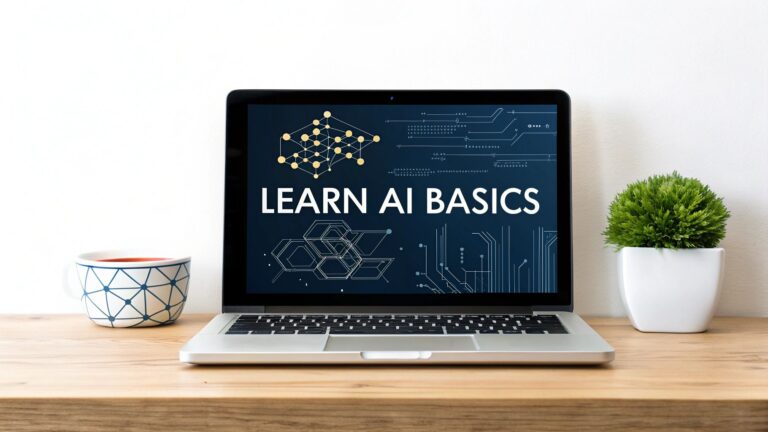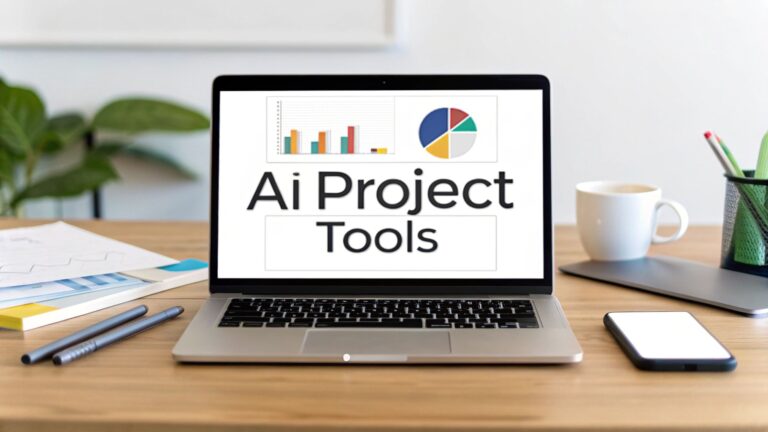A Practical Guide to Machine Learning for Businesses
When you hear "machine learning," it's easy to get lost in the tech jargon. But let's be honest, for a business, the idea is actually pretty simple. It’s all about using the data you already have to find hidden patterns, figure out what's coming next, and automate those everyday tasks that eat up so much time.
Instead of being manually programmed for every little thing, machine learning systems learn and get smarter over time—just like a person does. Think of it as a super-powered assistant who helps you make better decisions, really get to know your customers, and run a much more efficient ship. It's less about robots and more about results.
What Is Machine Learning in a Business Context?

Let's cut through the noise. Forget the sci-fi robots and walls of code for a moment. For a business owner, machine learning is a practical tool, not some futuristic fantasy.
Imagine hiring a new analyst who, on day one, dives into all your past sales reports, customer feedback, and website traffic logs. But this isn't just about organizing data into neat spreadsheets. This analyst actually learns from it.
They start spotting subtle connections you might have missed—like which types of customers are most likely to make a repeat purchase, the exact time of day your marketing emails get the best engagement, or which two products are almost always bought together. Before long, they're using that knowledge to make stunningly accurate predictions and take routine work off your plate.
That, in a nutshell, is machine learning for businesses. It’s not about replacing your gut instinct; it’s about backing it up with powerful, data-driven insights.
Beyond the Buzzwords
At its core, machine learning is a branch of artificial intelligence (AI). While AI is the big-picture idea of creating machines that can think or act intelligently, machine learning is the engine that makes much of it possible by learning directly from data. If you want to get into the nitty-gritty, our guide explains the differences between deep learning vs machine learning in more detail.
For your business, this translates to turning the information you collect every single day into a real strategic advantage. Every sale, customer interaction, and marketing click generates data. ML provides the tools to finally unlock the valuable secrets hidden inside.
"Your job will not be taken by AI. It will be taken by a person who knows how to use AI."
– Christina Inge, Author & Instructor at Harvard Division of Continuing Education
This quote really hits the nail on the head. Adopting machine learning isn't about some massive, intimidating tech overhaul. It's about giving your team smarter tools to help them focus on what they do best. It’s a force multiplier for your existing talent.
Why Should Your Business Care?
The real reason to care about machine learning is simple: it helps you make better, faster, and more profitable decisions. It shifts your strategy from just reacting to what happened yesterday to proactively shaping what happens tomorrow.
By putting your data to work, ML can help you tackle some major goals:
- Predict Future Trends: Imagine forecasting demand for a new line of winter coats with 90% accuracy, so you can optimize inventory and avoid both costly overstock and frustrating stockouts.
- Automate Tedious Processes: You can hand off routine tasks like sorting customer support tickets or filtering spam, freeing up your team to handle complex customer issues that require a human touch.
- Understand Your Customers: Go beyond basic demographics and analyze behavior to deliver personalized recommendations and marketing that truly connects. Think Netflix suggesting your next favorite show.
Ultimately, integrating machine learning for businesses is about sharpening your competitive edge. It’s about using the information right under your nose to build a more efficient operation and create experiences that turn customers into fans. In the next few sections, we'll dive into the tangible benefits and real-world examples that show exactly how this works.
What Can Machine Learning Actually Do for Your Business?
Let's move beyond the textbook definitions. The real question isn't what machine learning is, but what it can actually do for you. The magic isn't in the fancy algorithms; it's in the real-world results they deliver. When businesses bring machine learning into the fold, they typically see powerful gains in three key areas that are crucial for growth.
Think of it like giving your company a major software update. You're not just running the business anymore—you're making it smarter, faster, and much more tuned in to what your customers and the market are doing.
Supercharge Your Operations
One of the first things you'll notice with machine learning is how it can free up your team. It's brilliant at handling the kind of repetitive, time-consuming tasks that eat up so many hours in the workday. This isn't about replacing people; it's about letting them focus on bigger-picture work that needs a human touch—like strategy, innovation, and creative problem-solving.
Take an e-commerce company, for example. Instead of someone manually sifting through hundreds of customer support emails, an ML model can instantly sort and tag them. It can figure out if a message is about a "return," a "shipping delay," or a "broken product" and route it to the right person. Your team spends less time on administrative grunt work and more time solving real customer problems, which is a huge win.
This kind of automation is quickly becoming the new normal. We're seeing a massive shift from early experiments to full-on adoption.
"The biggest immediate win for most businesses with ML is automating the mundane. If you can free up 10 hours a week for your key people by automating a repetitive task, that's not just a cost saving—it's 10 extra hours they can spend on innovation and growth. It's an incredibly powerful first step."
– Industry Expert Opinion
By 2025, an estimated 78% of organizations worldwide will be using artificial intelligence and machine learning in at least one part of their business. That's a huge leap from just 55% in 2024. On average, companies are now using AI and ML in three different areas, which shows it's no longer just a side project. Discover more insights on AI adoption from Netguru's analysis.
Make Smarter, Data-Backed Decisions
Every day, your business creates mountains of data. But is that data just a record of the past, or is it a roadmap for the future? Machine learning is what turns all that historical information into a tool for predicting what's likely to happen next. This gives you the power to stop reacting and start making proactive, well-informed decisions.
Imagine you're a retailer trying to figure out how much inventory to order for the holiday season. The old way might be to just look at last year's sales. The ML way is to analyze a whole host of factors all at once:
- Past sales figures, of course
- Current market trends and social media buzz
- Upcoming holidays or even local festivals
- Weather forecasts that might affect shopping habits
By finding the hidden connections in all this data, a model can forecast demand for specific products with incredible accuracy. That means you're not stuck with expensive overstock, and you don't lose out on sales because a popular item ran out. It’s a game-changer for anyone trying to build a leaner, more efficient supply chain.
Deliver Experiences Customers Love
In today's market, a generic, one-size-fits-all approach just doesn't cut it. Customers want to feel seen and understood. Machine learning is the key to delivering that kind of personalized experience, and doing it at a scale that would be impossible for any human team.
We've all seen this in action with recommendation engines on sites like Amazon or Netflix. When a platform suggests a movie you end up loving or a product that perfectly complements something you just bought, that's ML doing its thing. It's analyzing your past behavior—what you've watched, browsed, or purchased—and cross-referencing it with millions of other data points to make an educated guess about what you'll like next.
This creates a fantastic loop. The customer gets a more helpful and enjoyable experience, which makes them more loyal and more likely to buy again. You move from just pushing products to actually building relationships.
Practical Examples of Machine Learning in Action
Theory is one thing, but seeing machine learning work in the real world is where it really clicks. Let's move past the abstract concepts and look at how businesses like yours are actually using this technology to solve real problems, grow revenue, and make customers happier every single day.
This isn't some far-off, futuristic idea. It's about practical tools delivering measurable results right now. In fact, you've probably interacted with these systems dozens of times today without even realizing it.
The infographic below really brings this to life, showing how machine learning's core strengths—like finding patterns and making predictions—branch out to boost efficiency, drive smarter decisions, and create better customer experiences.

As you can see, ML isn’t just a niche tool for one department. It's becoming a central engine that powers improvements across the entire business.
How Retailers Create Personalized Shopping
Ever felt like an online store just gets you? That’s almost certainly a recommendation engine at work, one of the most common and effective uses of machine learning for businesses.
Think about it this way: a customer buys a new camera. A basic system might suggest a generic memory card. But a system powered by machine learning goes much, much deeper. It looks at the purchase history of thousands of other people who bought that exact same camera. It notices that a significant number of them also bought a specific tripod, a high-quality lens cleaning kit, and a particular brand of camera bag.
Suddenly, the recommendations aren't just random add-ons. They're a curated set of products that genuinely fit the customer’s needs. This leads to a higher average order value for the store and a far more helpful shopping experience for the customer.
Another powerful tool in retail is dynamic pricing. Airlines and ride-sharing apps have been doing this for years. A machine learning model constantly sifts through factors like demand, competitor prices, the time of day, and even local events to adjust prices in real-time. This keeps the business competitive while making sure they’re not leaving money on the table.
Securing Transactions in Finance
The financial world was one of the earliest and biggest adopters of machine learning, especially when it comes to security. With millions of transactions happening every minute, it's simply impossible for humans to monitor everything for fraud. This is a perfect job for ML.
Take credit card fraud detection. A model is trained on millions of past transactions, learning the subtle patterns of your normal, legitimate spending habits. It knows your typical purchase locations, your average spending amounts, and the kinds of stores you visit.
When a new transaction comes through, the model checks it against your profile in milliseconds. A big purchase from a different country at 3 AM? That's an immediate red flag. The system can automatically block the transaction and send you an alert, stopping fraud before it even happens. That kind of proactive security builds incredible customer trust.
The financial industry's bet on this technology is massive. The global machine learning market is expected to reach an incredible $113.10 billion in 2025. Within that, banks are at the forefront: by 2025, 85% will use ML for data-driven insights, 79% for automation, and 78% for security. You can dig into the numbers in this in-depth analysis of machine learning statistics by Itransition.
Preventing Downtime in Manufacturing
For any manufacturer, an unexpected equipment failure is a disaster. It means costly downtime, missed deadlines, and a production line grinding to a halt. This is where predictive maintenance comes in, helping companies get ahead of problems before they happen.
Sensors are placed on critical machinery to gather data on things like temperature, vibration, and pressure. A machine learning model is then trained on this data to learn what "normal" operation looks and feels like.
The model then watches the live data stream, constantly looking for tiny changes that could signal a future problem. For example, it might pick up a slight increase in vibration that's undetectable to a human but indicates a bearing is starting to wear out. This triggers an alert, allowing the maintenance team to schedule a repair during planned downtime—long before the machine actually breaks. This smart, data-first approach saves companies millions.
"The most successful machine learning projects don't start with a desire to 'do AI.' They start with a clear, high-impact business problem. Find the friction, find the pain point, and then ask how data can solve it. The technology should always be the answer, not the starting question."
– Andrew Ng, Co-founder of Google Brain & Coursera
This expert insight gets to the heart of the matter. The best applications of machine learning for businesses are born from necessity. They are targeted solutions to real-world challenges, making them powerful tools for growth and efficiency.
The table below provides a quick snapshot of how various industries are putting these concepts into practice.
Machine Learning Applications Across Industries
| Industry | Business Problem | Machine Learning Solution |
|---|---|---|
| E-commerce | Low customer conversion and cart abandonment | Personalized product recommendations and targeted ads |
| Finance | High risk of fraudulent transactions and loan defaults | Real-time fraud detection and credit risk scoring |
| Healthcare | Inaccurate disease diagnosis and slow drug discovery | Medical image analysis (X-rays, MRIs) and predictive modeling |
| Manufacturing | Unplanned equipment downtime and quality control issues | Predictive maintenance and automated visual inspection |
| Marketing | Inefficient ad spend and poor customer segmentation | Customer lifetime value (CLV) prediction and churn analysis |
| Logistics | Inefficient delivery routes and inventory management | Route optimization and demand forecasting |
As you can see, the underlying theme is consistent: identify a costly or inefficient process, and then apply machine learning to make it smarter, faster, and more reliable.
Your First Steps with Machine Learning
Jumping into machine learning can seem daunting, like you need a massive budget and a dedicated team of data scientists right out of the gate. But that's usually not the case. The real key is to start smart with a clear, focused plan that tackles a genuine business challenge from day one.
Think of it like renovating a house. You wouldn't just start knocking down walls randomly. You’d pick one room—maybe the kitchen—where an upgrade will make the biggest difference in your daily life. Your first steps with machine learning should follow the same practical logic.
Pinpoint a High-Impact Business Problem
The best machine learning projects don't start with a love for technology. They begin with a real, nagging business problem. Before you get lost in algorithms and data sets, ask yourself: where is the biggest friction point in my business right now?
What’s a process that's too slow, costs too much, or relies too heavily on guesswork? Identifying that specific pain point is the most important thing you can do. It gives your project a clear purpose and a way to measure success.
Here are a few common areas where businesses find quick wins:
- Customer Churn: Why are our customers leaving? More importantly, can we figure out who is likely to leave next so we can do something about it?
- Lead Scoring: Of all our sales leads, which ones are actually going to convert? Let's help the sales team focus their energy where it counts.
- Inventory Management: How can we get better at forecasting demand? We need to stop overstocking items that don't sell and running out of our best-sellers.
Picking a problem with a clear, quantifiable outcome is crucial. A successful first project builds incredible momentum and makes it much easier to get support for bigger initiatives down the line.
Check if Your Data Is Ready for the Job
Once you have your problem nailed down, it's time to look at your data. Think of a machine learning model as a new employee you're training—it needs good, clean information to learn from. The old saying "garbage in, garbage out" has never been more true.
You don't need perfect data, but you do need data that’s relevant to the problem and at least somewhat organized. Ask yourself a few basic questions:
- Are we even collecting data related to this problem?
- Is that data stored somewhere accessible, like a CRM, database, or even just organized spreadsheets?
- Is the data mostly complete, or are there huge, glaring gaps everywhere?
This isn't about becoming a data engineer overnight. It's just a quick reality check to see if you have the raw materials you need. If you find your data is a complete mess, then maybe your first project is simply to start collecting and organizing it properly.
"Many businesses are surprised to find they're already sitting on a goldmine of data. The challenge isn't a lack of information, but knowing how to put it to work. Starting with a small, well-defined problem is the best way to turn that raw data into a real competitive advantage."
– Industry Expert Opinion
This really drives home the point that the first step is often just about organizing what you already have. Making sense of your existing information is the bedrock of any successful machine learning project.
Build a Team or Use Off-the-Shelf Tools
With a problem defined and your data checked, you've hit a fork in the road. Should you build a custom solution from scratch or use an existing tool? A decade ago, hiring a team of expensive specialists was pretty much the only option. Today, things look completely different.
Building an In-house Team:
- Pros: You get a solution that’s perfectly customized to your unique business needs.
- Cons: It’s incredibly expensive, takes a long time, and requires hiring very specialized talent.
Using Off-the-Shelf ML Tools:
- Pros: They are far more affordable, much faster to get running, and are often designed for people who don't have a data science background.
- Cons: They’re less customizable and might not be a perfect fit for every single niche problem.
For the vast majority of businesses just getting started, using an off-the-shelf tool is the smartest move. So many modern CRMs and marketing platforms already have powerful machine learning features built right in. You can learn more about the benefits of automating machine learning and see how accessible tools are changing the game for businesses of all sizes.
Launch a Small Pilot Project
Okay, it’s time to put your plan into action. The final step is to launch a small, low-risk pilot project. The goal here isn't to transform your entire company in one fell swoop. It's to prove the concept, show some real value, and learn from the process in a controlled environment.
A good pilot project needs a clear timeline (say, 90 days), a specific budget, and a defined metric for what success looks like. For instance, your goal might be to "reduce customer churn by 5% within one quarter" by using a model that flags at-risk customers so your support team can reach out with a special offer.
By starting small, you can test your ideas, iron out the kinks, and get tangible results without a massive upfront investment. That first success story becomes your most powerful tool for getting the resources and buy-in you'll need to tackle even bigger challenges later on.
Overcoming Common Machine Learning Challenges

Jumping into machine learning is exciting, but let's be real—it's rarely a simple plug-and-play process. Like any powerful business initiative, it brings its own set of very real hurdles. Knowing what these challenges are ahead of time is the best way to develop a smart strategy to get past them.
The journey into machine learning for businesses isn’t about trying to sidestep every problem—that's impossible. It's about being ready to solve them when they pop up. Let's dig into the most common issues and, more importantly, how you can practically deal with them.
The Garbage In, Garbage Out Problem
One of the first—and most critical—roadblocks is data quality. A machine learning model is only as smart as the data you train it on. If you feed it messy, incomplete, or irrelevant information, you'll get inaccurate and useless results. It's a classic case of "garbage in, garbage out."
This doesn’t mean your database needs to be pristine from the get-go. The real solution is to start with a focused data readiness assessment. Before kicking off any project, spend time cleaning and organizing the specific dataset you'll be using. Simple steps like removing duplicates, filling in missing values where possible, and standardizing formats can make a massive difference.
"Many businesses are so focused on the algorithm that they overlook the data. Your model's success is determined long before the first line of code is written; it begins with high-quality, relevant data. Prioritize data hygiene as your foundational first step."
– Cassie Kozyrkov, Chief Decision Scientist at Google
Bridging the Talent and Skills Gap
Another big question on every business leader's mind is finding people with the right skills. The high demand for data scientists and ML engineers can seem daunting, but this talent gap is being filled in some pretty creative ways.
The AI market is projected to create 170 million new roles globally over the next decade, with a net gain of 78 million jobs. This points to a huge shift toward building new skills. In fact, a staggering 90% of tech workers now use AI tools every day—a huge leap from just 14% in 2023. You can see more on this rapid workforce shift in this recent AI statistics report by Exploding Topics.
For your business, this opens up two smart pathways:
- Invest in your people: Offer training to your current analytical and tech-savvy employees. You can help them grow into the new roles you need to fill.
- Embrace user-friendly tools: Many modern platforms now offer powerful ML features without needing a deep coding background, empowering your existing team to get incredible results.
Moving From Insight to Action
Maybe the most underrated challenge of all is actually getting your team to use the insights your models produce. A brilliant predictive model is completely worthless if its findings just sit in a report that nobody reads or acts on.
The trick is to make the insights accessible and directly tied to an action. This could be a simple dashboard that flags at-risk customers for your sales team, or an automated inventory alert sent straight to your supply chain manager. Proper machine learning model deployment is all about building a bridge between the model's output and your team's daily decisions, ensuring the value isn't lost in translation.
The Future of Your Business Is Data-Driven
We've covered a lot of ground—from the core concepts and real-world examples to the hurdles you might face along the way. Now, let's pull it all together. Machine learning isn't some far-off, complicated idea just for Silicon Valley giants anymore. It's a real, practical tool that businesses of any size can start using right now to get ahead.
The main takeaway is simple: starting small is better than not starting at all. You’ve seen how ML can sharpen efficiency, lead to smarter decisions, and build customer experiences that competitors just can't match. The path to using machine learning for businesses doesn't start with hiring a massive data science team or sinking a fortune into new tech.
"Your job will not be taken by AI. It will be taken by a person who knows how to use AI."
– Christina Inge, Author & Instructor at Harvard Division of Continuing Education
This hits on a crucial point. It’s not about replacing people; it's about giving them better tools. The goal is to turn the data you’re already sitting on into your most powerful asset.
Your Next Actionable Step
So, what do you do right now? It’s probably simpler than you think. Don't worry about mastering complex algorithms just yet. Instead, look closely at your own business.
Find one single process, one nagging problem, or one unanswered question you deal with every day. Something that could be solved if you just had a bit more insight.
- Could you figure out which customers are about to churn?
- Could you get a better handle on your inventory?
- Could you finally see which marketing dollars are actually bringing in sales?
Just picking one of these questions and looking for answers in your data is your first real step. That’s how you start building smarter operations, making better calls, and carving out a competitive advantage that lasts. The future you want is built on the insights you start uncovering today.
Frequently Asked Questions
Even after getting a good handle on what machine learning is, it’s completely normal to have a few questions rattling around. This isn't just another piece of software; it’s a fundamental shift in how businesses can operate, so digging into the details is just smart. Let's tackle some of the most common things business leaders ask when they first start exploring what machine learning for businesses really means.
The idea here is to give you straight answers you can actually use to make decisions, without getting bogged down in overly technical language.
Do I Need a Team of Data Scientists to Use Machine Learning?
Not necessarily, and definitely not like you used to. A few years ago, the answer would have been a resounding "yes." Building a predictive model from scratch was a heavy lift that required a team of specialists. But things have changed a lot.
Today, powerful machine learning features are often baked right into the software you already use. Think about your marketing automation platform that scores leads automatically or the CRM that segments customers for you—that's ML working behind the scenes. You can get started with these kinds of user-friendly, off-the-shelf tools. Only when your needs get really specific does it make sense to think about bringing on a dedicated team.
How Much Does It Cost to Implement Machine Learning?
This is probably the trickiest question because the answer is "it depends"—a lot. It's like asking, "How much does a vehicle cost?" You could be talking about a simple scooter or a massive freight truck, and the price tags are worlds apart.
Here’s a rough breakdown of what you might be looking at:
- SaaS Tools: Many platforms with built-in ML features run from a few hundred to a few thousand dollars per month. This is the most popular starting point for most companies.
- Pilot Projects: If you want to test a specific idea, a small-scale project with a consultant could cost anywhere from $10,000 to $50,000. The goal is to prove a clear ROI before you go all-in.
- In-House Teams: Building a custom solution from the ground up and hiring your own experts is a major investment, often pushing into the hundreds of thousands of dollars per year.
A pilot project with a fixed budget is a great way to test the waters. It lets you see the value for yourself before you commit to something bigger.
What Is the Difference Between AI and Machine Learning?
It’s really common to hear these terms used interchangeably, but they aren't the same thing. There’s a simple way to think about their relationship.
Artificial Intelligence (AI) is the big, overarching goal of creating machines that can think or act like humans. It's the entire universe of "smart" technology. Machine Learning (ML), on the other hand, is a specific method for achieving AI. It’s the most successful and widely used branch of AI right now, where systems learn from data to make predictions without being explicitly programmed for every scenario.
So, all machine learning is a form of AI, but not all AI is machine learning. ML is the engine that powers most of the intelligent tools we use in business today.
Ready to turn data into your most powerful asset? At YourAI2Day, we provide the latest news, insights, and tool reviews to help you confidently navigate the world of AI. Explore our resources today!







